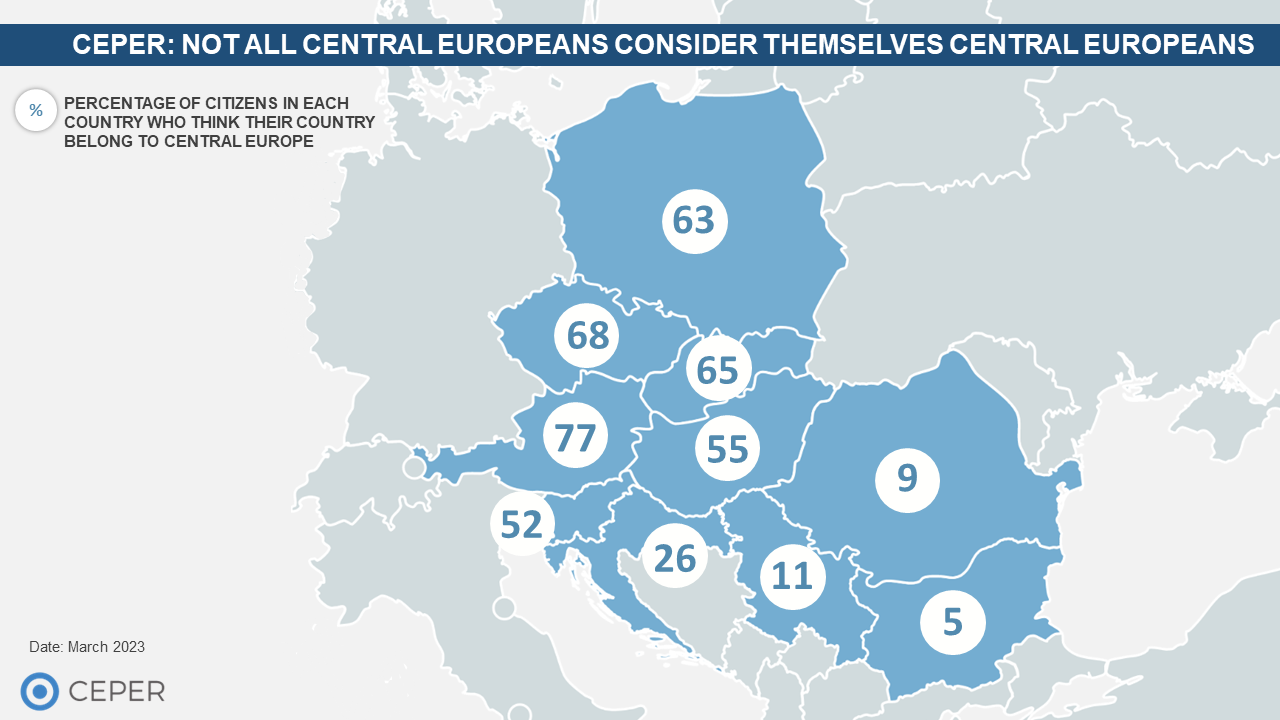CEPER: Not All Central Europeans Consider Themselves Central Europeans
A clear majority of respondents from Austria, Czechia, Slovakia, Poland, Hungary, and Slovenia identified their countries as Central European in the surveyed region, located in between the borders of Germany and the former Soviet Union. Croats, Serbs, Romanians, and Bulgarians in majority do not consider themselves Central Europeans.

The part of Europe squeezed in between Germany and the borders of the former Soviet Union is usually referred to as Central Europe – even without the certainty that countries in this region actually identify themselves as such. To map the association between Central Europe and the countries of this part of Europe respondents from 10 European countries were asked to which part of Europe their country belong and were offered a choice between placing their home country to Eastern Europe, Western Europe, Central Europe or to the Balkans.
A clear majority of respondents from 6 countries agreed on Central Europe as their home region: 77% of Austrians, 68% of Czechs, 65% of Slovaks, 63% of Poles, 55% of Hungarians, and 52% of Slovenes. The clear appeal of Central Europeanness is also demonstrated by the large margin of difference between a Central European and any other regional belonging that respondents from these countries stated. Despite some of the regional, post-communist countries’ perception of Austria as Western, 64% more Austrians identified their country as Central European than Western European. In Czechia the gap between Central Europe and the second most commonly cited Western European regional belonging was 53%. In Poland 47%, in Slovakia 45% while in Hungary 32% more claimed a Central than an Eastern European identity for their countries. In Slovenia the difference between the percentages of those choosing Central Europe and the second most frequent response, the Balkans was 24%.
In Hungary 8% and in Slovenia 28% claimed to associate their countries with the Balkans. In Hungary the notion of the country being the Gate to the Balkans, while in Slovenia the Yugoslavian past might explain the association with the peninsula. In Poland, Slovakia, and Czechia practically no respondents mentioned to belong to the Balkans. The ease with which most Central European countries collectively ruled out the Balkans as their regional belonging demonstrates the clarity with which they share a Central European regional identity.
The vision many of these countries had over the centuries about the role of this part of Europe in the world greatly underlies the strength of association with the notion of Central Europe. While Austria derives its settled belonging to Mitteleuropa or Central Europe from its Austro-Hungarian past and strong ties to Germany, under different names, Poland, Hungary, Czechia, and Slovakia all had a clear vision for a Central European cooperation. The Visegrad 4 or the Three Seas Initiative are the most recent and famous formats of partnership fostered by the strong sense of Central Europeanness that the CEPER survey also observed.
While in the above-mentioned 6 countries over 50% of respondents agreed that they are indeed Central Europeans, in the remaining 4 countries only a minority of respondents endorsed this regional classification of their countries. In Croatia 26%, while in Serbia 11% associated their countries with Central Europe – that is, in Croatia about half, while in Serbia about one fifth as many respondents thought about their countries as Central European than in Slovenia, who similarly shares a Yugoslavian historic legacy.
In Romania 9%, while in Bulgaria an expectedly small 5% claimed their country’s Central Europeanness. Both in Serbia (75%), Bulgaria (50%), and in Croatia (36%) most respondents identified their countries as part of the Balkans, while only in Romania did a majority of respondents chose Eastern Europe (with 57%) as the region they identify their country with.
In short, as one moves from East to West, from Romania to Austria or from South to North, from Croatia to Poland, the association with Central Europe gradually increases. That is, not in all 10 surveyed countries do the majority of respondents view their home states as part of Central Europe, however, in most countries that are conventionally labelled as Central European, this regional identity has an appeal. As a result, it is not mistaken to continue to refer to EU member states East from Germany as Central Europe.
Methodology
The opinion-poll survey was carried out in 10 countries in the Central European region: Austria, Bulgaria, Croatia, Czech Republic, Hungary, Romania, Serbia, Slovakia, Slovenia and Poland. The data were collected between 20 February and 10 March 2023. The survey was conducted by telephone (in person in Serbia) with 1000 respondents per country. The sample per country is representative by gender, age and type of settlement.
|
|
Austria |
Bulgaria |
Croatia |
Czechia |
Poland |
Romania |
Serbia |
Slovakia |
Slovenia |
Hungary |
|
Eastern Europe |
4 |
27 |
9 |
11 |
16 |
57 |
9 |
20 |
6 |
23 |
|
Western Europe |
13 |
13 |
22 |
15 |
15 |
2 |
4 |
13 |
8 |
5 |
|
Central Europe |
77 |
5 |
26 |
68 |
63 |
9 |
11 |
65 |
52 |
55 |
|
Balkans |
3 |
50 |
36 |
1 |
0 |
29 |
75 |
0 |
28 |
8 |
|
DK/NA |
3 |
5 |
7 |
5 |
6 |
3 |
1 |
2 |
6 |
9 |
Data from March 2023
Question: In your opinion, to which part of Europe does your country belong?
About us
CEPER is the brand of CEPER Group GmbH. The CEPER acronym abbreviates Central European Perspectives. CEPER's area of expertise is Central European affairs, the company offers media monitoring, market research and opinion polls from the region to its clients.